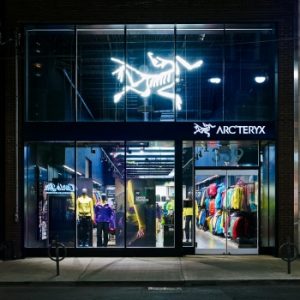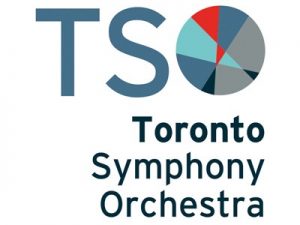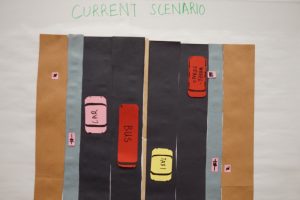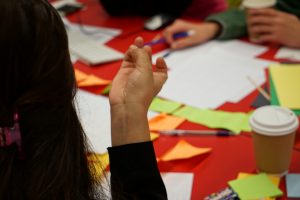Our sixth hackathon explored inclusive design from two perspectives. One is to make businesses and services more accessible. The second revolves around the idea of re-designing or re-inventing one of your creations, products or goods.
Team 1: Arc’teryx
Arc’teryx was founded by single-minded climbers in need of better equipment, to meet the challenges of our harsh Coast Mountain range. They believe design is a process: prototype, test, revise. Driven by the specific needs of each product.

Challenge
The challenge brought by Arc’terix Toronto was: How can we make a more convenient accessible zipper while still maintaining its function for outdoor use?
Solution
Initially, the team researched a magnetic solution to aid in one-handed zipping, but this would not work on a double-zipper. Finally, they found that velcro was the best solution. High-quality velcro will last longer and will not compromise the durability of the jacket or seal. Offering different coat lengths (zipper lengths) for different body types and disabilities. The potential idea for a plastic silhouette where the double zip can be more easily secured.
Prototype


Team ARC’TERYX Hack’s Prototype
Team 2: Bank of Montreal
BMO Financial Group is a Canadian multinational investment bank and financial services company.

Challenge
At the BMO, there is an open space to gather for meetings. There is a system to book, but it is not easy to find yours. How can the BMO make it easier for employees to find the meeting places that they have booked online?
Solution
App for personal cellular that:
● Book the room and
● Guides to get there
Prototype

Team BANK OF MONTREAL’s Prototype
Team 3: Metrolinx
Metrolinx is a Crown agency that manages and integrates road and public transport in the Golden Horseshoe region, which includes the cities of Toronto and Hamilton and area, in the province of Ontario in Canada.

Challenge
The city wants to install protected bike lanes along main roads, but specialized transit customers need to be picked up and dropped off. In the current design, they either have to cross the bike lane, or the transit vehicle has to block the bike lanes. What can be done?

Process
The group brainstormed:
- User groups: Wheel-Trans users, delivery people, bikers, walkers, bus riders, car drivers, strollers, children.
- Modalities: curbs, paint, tactile pavement, signage, embedded lighting, sonic alerts.
- Incentives/disincentives: Enforcement, incentives.
Solution
● Protected sidewalk cut-outs are best but require wide sidewalks.
● When sidewalks are narrow the road could curve from side to side to leave drop-off zones for bus and Wheel-Trans passengers and commercial deliveries.
Prototype
Team 4: Royal Ontario Museum
The Royal Ontario Museum is a museum of art, world culture and natural history in Toronto, Ontario, Canada. It is one of the largest museums in North America and the largest in Canada. It attracts more than one million visitors every year, making the ROM the most-visited in Canada.


Challenge
The ROM provides tactile exhibition components with raised letters and braille labels that are “smattered” throughout the museum or a special exhibition – for visitors with full sight one looks around and sees them – or simply comes across them over the course of a visit.
How to improve the museum experience for visitors of all abilities, in particular in regards to way-finding and individual experiences with museum displays.

Solution
- Using visitor’s own smart devices (location-aware, i.e. beacon, GPS, QR codes or other technologies) or museum supplied device to provide way-finding and deliver content and experience.
- Contemplation space(s) with books, computer stations, braille books/large print books, tactile stations etc.
- Special ticketed entry times to meet the needs of visitors with diverse needs.
Prototype



Team ROYAL ONTARIO MUSEUM Hack’ Prototype
Team 5: Theatres
The number of audience members with a disability has increased to 7%, reveals a study of 6,500 productions by Purple Seven in the UK from 2012 to 2015.
Challenge
A local theatre company in Toronto has developed accessible programs and services but does not know how to effectively cannot reach out to the groups that could most benefit from the new inclusive features they are providing for.
Where they are advertising, the company don’t access their target demographic because they don’t know how to connect with the community. What would an accessible campaign look like and how should the company plan to reach their extended target audience?
Process
- Identify accessibility features provided by the theatre
- Identify key organizations in the disability communities
- Design a marketing package to bring communities to the theatre
- Design new features for continuous accessibility improvements
Solution:
- Reaching out disability communities: CWDO, CILT, CPA, CNIB, ASL, LSQ, Toronto Mental Health
Association, March of Dimes. - Arrange an interview with a theatre representative to talk about the fully accessible theatre experience
on CFRB. - Links on the theatre website, facebook, twitter etc. to presentations of accessible theatre experience in
different format: sign language, captioned. - The first time comers get a 50% discount.
- Public education: accessibility ads posters inside/outside the theatre while attracting the general public using an open library, colourful surroundings etc.
- Distribute newsletter each month in a year to promote new coming accessible features.
- Possible new features:
- Wireless access in the theatre to provide the audience with a different format of audio/video to explain
the show based on their needs. - Allow and help people who have accessibility issues to play kind of an own show rather than being audience only
- Wireless access in the theatre to provide the audience with a different format of audio/video to explain
Prototype
Team 6: Toronto Symphony Orchestra
The Toronto Symphony Orchestra is a Canadian orchestra based in Toronto, Ontario. Founded in 1922, the TSO gave regular concerts at Massey Hall until 1982, and since then has performed at Roy Thomson Hall. The TSO also manages the Toronto Symphony Youth Orchestra.


Challenge
TSO has recently received a patron suggestion to explore how the TSO may
better educate patrons on Multiple Chemical Sensitivity.
The challenge is reducing the harmful effects that scented products have on patrons encouraging everyone to “Go Scent/Fragrance-Free.”

Solution
- Creating an educational campaign with:
- Graphics
- Updated awareness: explaining what Multiple Chemical Sensitivity is and how it affects patrons
- Peer to peer marketing: a video presentation
- Opt-in message during purchase path to self-identify Multiple Chemical Sensitivity
- Would link to further information and allow for follow-up directly from the organization
- Creation of buttons
- Creation of scent free section
- When you buy a ticket in area, a pop-up explains that it’s a scent-free
section and what that means
- When you buy a ticket in area, a pop-up explains that it’s a scent-free












